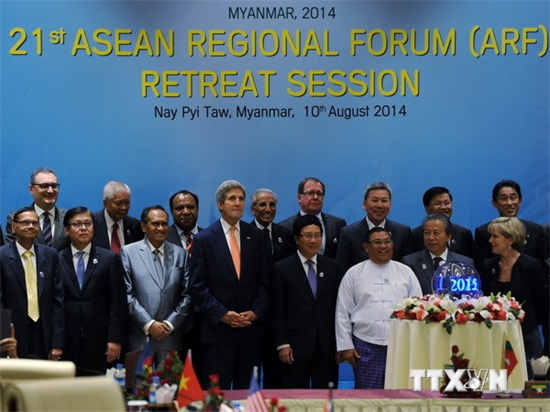The 21st ASEAN Regional Forum and ASEAN Centrality in the Regional Security Architecture
Under the framework of the ASEAN Ministers’ Meeting, the ASEAN Regional Forum (ARF) convened on 10 August 2014 in Nay Pyi Taw, Myanmar with the participation of 27 member countries. This is among top regional political-security forums held with the aim of implementing measures for confidence-building, preventive diplomacy, and security challenges contributing to enhancing ASEAN’s role and status in the regional security architecture.
 |
|
The ARF 21 held in Nay Pyi Taw, Myanmar 2014 (Photo: VNA) |
ARF – the significant multilateral security architecture of ASEAN
The ARF was officially founded on 25 July 1994 in Bangkok, Thailand with the participation of 18 member countries (under the initiative of the ASEAN’s Institute for Strategic and International Studies). Its primary aim is to hold dialogue and exchange ideas on issues of mutual concern regarding politics – security, confidence - building, and preventive diplomacy in the Asia – Pacific region. Meetings in the framework of ARF include: ARF Ministerial Meeting, ARF Senior Official Meeting and ARF Inter-sessional Meetings on confidence-building, preventive diplomacy, disaster relief, counter terrorist and trans-national crime, maritime security, nuclear-nonproliferation, disarmament. ARF has become the biggest political-security forum in the region. ARF has decided on its three-stage process of cooperation: promotion of confidence building measures, development of preventive diplomacy and elaboration of approaches to conflicts. The forum operates on the basis ASEAN’s model and consensus principle.
Thanks to its appropriate aims and roadmap to the regional and world situation, after 20 years of operation, ARF has gained significant achievements and seen rapid growth. To date, ARF has 27 member countries, namely: Australia, Bangladesh, Brunei Darussalam, Cambodia, Canada, China, Democratic People's Republic of Korea, European Union, India, Indonesia, Japan, Lao PDR, Malaysia, Mongolia, Myanmar, New Zealand, Pakistan, Papua New Guinea, Philippines, Republic of Korea, Russia, Singapore, Sri Lanka, Thailand, Timor-Leste, United States, and Viet Nam. With its scope and member’s responsibility, over the past years, ARF has contributed greatly to building the regional security environment.
ASEAN’s centrality in the evolving regional security architectures
Recently, in order to respond to newly-arisen security challenges, ASEAN’s leaders has agreed to form a regional security architecture which is multi-layered, inter-connected, supplementary and supportive based on the existing regional cooperation mechanisms while ensuring ASEAN’s key and central role in the region. Meanwhile, with regard to the independence, sovereignty as well as a peaceful and stable environment, and development for regional countries, especially small and medium ones, they did not approve of a single regional architecture overwhelming the whole Asia-Pacific region. To promote its centrality in the regional security architecture, ASEAN need to focus on the followings:
First, ASEAN needs to continue maintaining and strengthening its centrality in the region, especially in visualizing the security architecture in accordance with special traits of South East Asia and ASEAN’s interests. Accordingly, ASEAN support of a regional architecture which is based on the existing forums featuring ASEAN’s centrality such as ASEAN+1, ASEAN+3, ARF, ADMM+ and EAS while encourage and offer favourable conditions for its partners’ deeper participation in the region’s cooperation forums.
Second, ASEAN needs to actively facilitate dialogue and cooperation in forums, mainly the ARF and EAS, to enhance confidence building, and its strong sense of community to effectively respond to security challenges. ARF continues to carry out the set-out programs, plans, particularly the combination of confidence building and preventive diplomacy; EAS continues to be a forum of leaders focusing on solutions to regional political - security issues of strategic importance, such as: maritime security, natural disasters, …
Third, ASEAN implements its general plan on building the ASEAN’s Political-Security Council (APSC) in every field, especially areas of priority such as: counter terrorist, trans-national crime, etc. Besides, the bloc is to build its strategic plan on consolidating coordination and promote its role in international forums and organizations as well as world issues of mutual concern.
Fourth, ASEAN strengthens and promotes further the value and importance of agreements, mechanisms, cooperation instruments for regional peace, security and stability, such as: The Treaty of Amity and Cooperation (TAC), Treaty on the Southeast Asia Nuclear Weapon-Free Zone (SEANWFZ) and the Declaration on Conducts of Parties in the East SEA (DOC),… along with its responsible participation in settling the issues regarding maritime safety and security and disputes in the East Sea.
Fifth, ASEAN fosters cooperation with regional countries in order to effectively respond to ongoing non-traditional security challenges; effectively implements the ASEAN Agreement on Disaster Management and Emergency Response to enhance its capability and ability to opportunely respond to emergencies; discusses methods for enhancing cooperation between ASEAN and its partners regarding this field.
Regarding complex issues in bilateral relationships within the bloc, ASEAN is consistent with its policy of dialogue, confidence building and settling disputes by peaceful measures in line with international laws, the UN Charter and the ASEAN Charter, etc. This is the prerequisite, the invariable principles for ASEAN to maintain and promote its centrality in the regional security architecture.
Colonel Do Mai Khanh
Deputy Director of the Institute for Defence International Relations